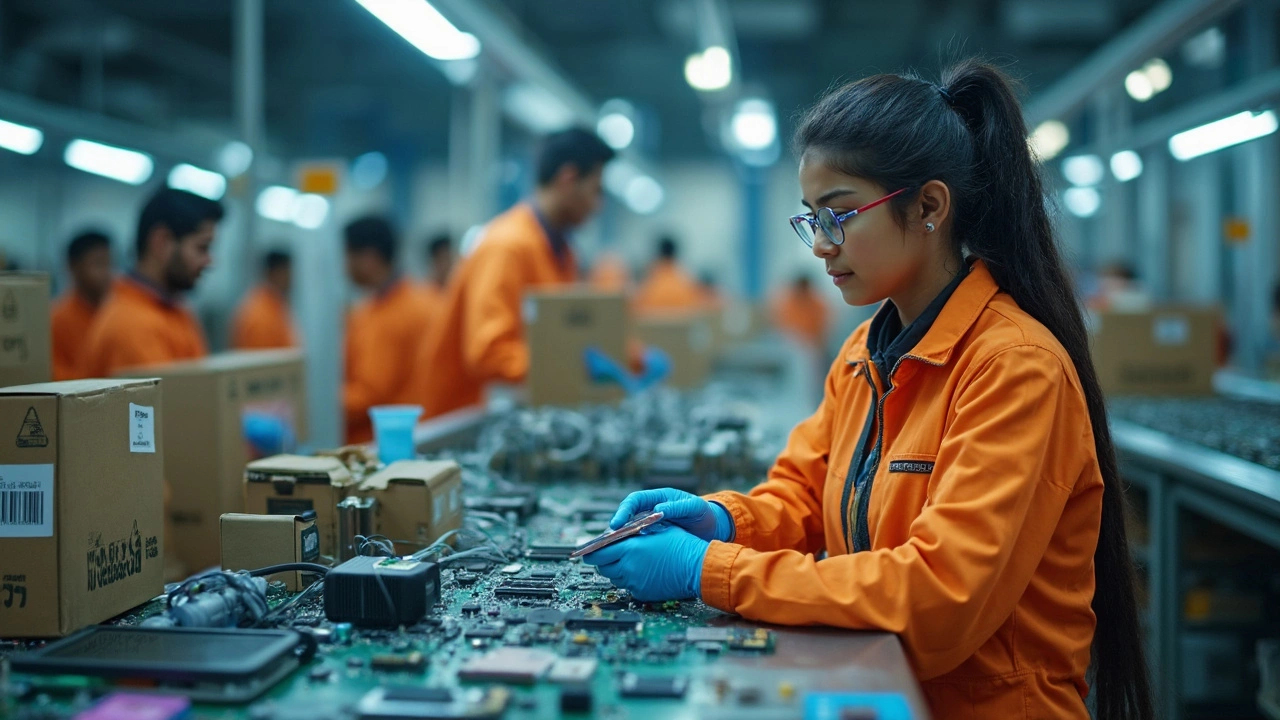If you asked your parents what India exported most, chances are they’d say tea, textiles, or maybe IT services. But things have changed big time in the past decade. The electronics sector, which barely registered on the export radar years ago, is now one of the main acts—and smartphones are leading the charge.
Why should you care? Well, the electronics industry isn’t just bringing in serious cash for the country; it’s shaking up the job market and making India a key player in the global supply chain. Plus, the devices you use every day, from your phone to your smart TV, might soon be ‘Made in India’ if they aren’t already.
The biggest tip for anyone watching this space: don’t ignore the signs. Investment in electronics factories—mostly clustered in places like Noida and Chennai—is booming because global giants like Apple and Samsung now see India as a manufacturing powerhouse. There’s a wave of opportunity, whether you’re thinking of careers, investing, or just curious about where the next tech leap will come from.
- From Textiles to Tech: India’s Export Story
- The Rise of Electronics: What Changed?
- Smartphones Take the Spotlight
- Who’s Leading the Charge?
- Challenges on the Road
- What This Means for You and the Future
From Textiles to Tech: India’s Export Story
Think back a few decades, and India’s main exports were pretty much all about cotton, tea, and a flood of textiles. For years, India’s handloom saris, carpets, and ready-made garments filled shops across Europe and America. Even now, you’ll find ‘Made in India’ labels peeking out of clothes in big brands, but something huge has shifted in the last ten years.
IT services took over in the 2000s, turning cities like Bengaluru into “Silicon Valley of India.” Software, back-end services, and tech support became massive earners. But fast forward to the 2020s, and now electronics manufacturing—especially phones—has grabbed the spotlight. This change didn’t happen by accident. The Indian government rolled out special plans like the Production Linked Incentive (PLI) scheme. Companies manufacturing phones, TVs, and tablets got big rewards if they made more in India instead of importing parts.
To see how things have changed, just look at the last couple of years. Back in 2015, India's electronics exports were worth only $6 billion. By 2024, that number shot up to over $20 billion—with smartphones making up the biggest slice. Here’s a quick comparison:
| Year | Textiles Exports (USD Billion) | Electronics Exports (USD Billion) |
|---|---|---|
| 2015 | 35 | 6 |
| 2020 | 29 | 11 |
| 2024 | 37 | 20+ |
This isn’t just a numbers story. Look at how phones from brands like Apple and Xiaomi, once imported, are now being assembled in huge Indian factories. Lots of folks who used to work in textile mills are switching over to roles in assembly lines, logistics, or tech support for these electronics giants.
So when you hear people talk about India being an IT hub, remember—now it’s gunning for the top spots in electronics manufacturing too. It’s a major shift, and the kind that creates lots of new kinds of jobs and business opportunities. If you’re thinking of riding this wave, this is the moment to pay attention to where things are headed.
The Rise of Electronics: What Changed?
It wasn’t long ago that India didn’t make much buzz in the global electronics manufacturing world. Fast forward to today, the story’s flipped. India’s electronics exports shot past $25 billion in 2024, making everyone—from small local firms to international tech giants—pay attention. But what actually changed?
First, the government rolled out some bold policies. Remember the ‘Make in India’ campaign? That one move in 2014 aimed at pulling global manufacturers into the country. Add to that the big push through Production Linked Incentive (PLI) schemes from 2020, and suddenly making gadgets in India became a lot more profitable for companies.
Second, companies like Apple, Samsung, and Xiaomi ramped up local assembly lines, especially for smartphones. A huge reason? China’s rising costs and supply chain hiccups during COVID-19 nudged a lot of tech giants to look elsewhere, and India was ready at the door. By the end of 2024, almost 7 out of every 10 smartphones exported from India had a major international brand stamped on them.
Here’s a quick look at how much things have changed:
| Year | Electronics Exports Value (USD Billion) |
|---|---|
| 2017 | 6.3 |
| 2021 | 15.6 |
| 2024 | 25.2 |
India also started building big electronics clusters in places like Noida (Uttar Pradesh), Sriperumbudur (Tamil Nadu), and Bengaluru (Karnataka). These hubs focus on everything from components to finished goods, making it easier for new players to set up shop without crazy logistics costs.
Another big nudge: a young, tech-hungry population at home and rising demand worldwide. This means companies don’t just have to export—they can also do a trial run with Indian customers before going global.
If you’re thinking about a job, investing, or starting something new, the ripple effects are clear. Electronics manufacturing isn’t just about gadgets anymore—it’s powering new jobs, new skills, and a shot for India to climb up that global supply chain ladder.
Smartphones Take the Spotlight
When people talk about electronics manufacturing in India, it’s hard not to mention smartphones. India has become one of the top smartphone manufacturing hubs in the world. Back in 2014, India was mostly just assembling phones from imported parts. Fast forward to now, and the scene looks totally different. Global brands like Apple, Samsung, and Xiaomi are all building or expanding huge factories here.
Thanks to policies like ‘Make in India’ and a bunch of tax perks for local manufacturing, India churned out over 200 million smartphones in 2023 alone. To put that into perspective, that’s almost one smartphone for every six people living in the country. A big chunk of these phones doesn’t just stay in India—millions get shipped out to Europe, Africa, and Southeast Asia.
Here’s a quick look at where things stand:
| Brand | Major Manufacturing Hubs | India-made Exports (2023) |
|---|---|---|
| Apple | Chennai, Bengaluru | Over $5 Billion |
| Samsung | Noida | About $4 Billion |
| Xiaomi | Greater Noida, Andhra Pradesh | $2 Billion+ |
Around 98% of all smartphones sold in India are manufactured within the country. You’ll spot an iPhone or a Galaxy with a “Made in India” tag more often now. India exported over $11 billion worth of mobile phones in 2023—ten times what it shipped just five years ago.
So what does this mean? The global smartphone market is looking to India to deliver. Factories here aren’t just screwing on backs and slapping on stickers. They’re handling high-value work: soldering chips, testing, packaging. And as the supply chain matures, experts say we’ll see even more core components—like displays and camera modules—being made right here.
If you’re thinking about working in tech or manufacturing, pay attention. Jobs in electronics manufacturing are growing fast. Even startups and smaller suppliers are getting opportunities as bigger companies seek local partners for parts and logistics. The smartphone wave isn’t slowing down—it’s giving a new face to India’s biggest export.

Who’s Leading the Charge?
If you’re wondering who’s behind India’s rise as a serious electronics manufacturing hub, a few names pop up over and over: Apple, Samsung, Foxconn, Dixon Technologies, and Tata Electronics. These aren’t just random companies—they’re giants who’ve set up shop in India for the long-haul.
Apple has been grabbing headlines. Until a few years ago, iPhones were mostly made in China, but now India makes almost 14% of the world’s iPhones. Apple has partners like Foxconn, Pegatron, and Wistron running massive factories, mostly in Tamil Nadu and Karnataka. Local companies supply parts, but these global players handle the main assembly lines.
Samsung isn’t sitting out either. Their Noida plant is actually one of the world’s biggest mobile phone factories, churning out millions of smartphones every month. Samsung’s focus isn’t only on high-end models; they make budget devices for India and other countries too, helping boost India's electronics exports.
Local players deserve a shoutout too. Dixon Technologies is now the go-to contract manufacturer for brands like Xiaomi, Motorola, and even Google. Another Indian company, Tata Electronics, is investing heavily to become a key supplier for Apple. Tata’s focus on precision components and assembling mobile parts is paying off as global demand climbs.
Let’s see some numbers to get a clearer picture:
| Company | Key Products | Indian Locations | 2024 Export Value (USD) |
|---|---|---|---|
| Apple (via Foxconn, Pegatron, Wistron) | iPhones | Tamil Nadu, Karnataka | $12 Billion |
| Samsung | Smartphones, TVs | Noida | $7 Billion |
| Dixon Technologies | Mobiles, TVs, Consumer Electronics | Uttar Pradesh, Andhra Pradesh | $1.5 Billion |
| Tata Electronics | Components, Mobile Parts | Tamil Nadu | $400 Million |
The common thread here? Major government incentives have drawn these players in. Programs like PLI (Production-Linked Incentive) offer financial perks for companies that boost manufacturing and exports. This nudges global brands to use India not just as a market, but as a factory for the world.
If you’re scouting for a job or investment, keep an eye on these leaders. When the big dogs set up shop, smaller suppliers and new startups tend to follow, creating a ripple effect across the electronics manufacturing scene.
Challenges on the Road
Building up electronics manufacturing for export has not come easy for India. Even though exports, especially in smartphone production, are booming, getting there has been like hopping over hurdles. Let's break down where the bumps in the road really are.
First up, supply chains. India still relies a lot on other countries, especially China, for components like semiconductors and display panels. That dependence means sudden price hikes or disruption from global events can throw a wrench in production—think back to the chip shortages in 2021 that hit almost every electronics maker worldwide.
Next, infrastructure. While places like Noida and Chennai are stepping up, not every industrial zone in India is ready for giant factories. Issues with power supply, road connectivity, or ports can slow things down. It’s not just about putting up buildings—moving finished goods out to global markets also needs smooth logistics.
Government policies and paperwork can be a headache too. Navigating customs, tax breaks, and changing regulations takes time and patience. Companies often face delays due to red tape, which isn’t exactly great for keeping up with overseas competition.
And yeah, skill shortage is real. The electronics field needs workers trained in everything from circuit design to advanced assembly. Big brands want consistency and speed, but finding people with the right know-how is still a challenge in many regions.
| Key Challenge | Current Status (2025) |
|---|---|
| Component imports | 73% still imported, mainly from China |
| Power & Infrastructure | Frequent outages, slow upgrades outside top cities |
| Customs & Red Tape | Average clearance takes 6-7 days |
| Skilled Workers | Shortfall of ~700,000 in electronics jobs |
The good news? The government has started pushing schemes like PLI (Production Linked Incentive), which rewards manufacturers for making more electronics locally. There’s also a push on ramping up chip fabrication and organizing job training programs focused on electronics manufacturing.
So, while you’ll keep hearing about record-breaking exports, remember there’s still a lot to iron out before India can claim its spot as the undisputed global factory for electronics.
What This Means for You and the Future
The boom in electronics manufacturing is not just some business headline—it actually matters more than you think. Here’s how this shift touches your daily life, wallet, and even your job prospects.
If you’re shopping for a new smartphone, there’s a good chance it’s assembled right here in India. In 2024, India exported over $15 billion worth of smartphones, with big names like Apple and Samsung moving a chunk of their production to Indian factories. That’s not just a stat—it’s more choices on the shelves, better after-sales support, and maybe even lower prices because you’re not paying for import duties or far-off logistics.
For anyone considering a career move, electronics manufacturing seriously opens up new doors. The sector has already created 450,000+ direct jobs and another 2 million indirect jobs, ranging from assembly line work to logistics and even app development. You don’t need to be an engineer to benefit—jobs in packaging, shipping, customer support, and warehouse management are booming, too.
India is fast becoming a tech export hub—even beating Vietnam to become the second-largest mobile phone manufacturer after China. This isn’t just about pride; it makes India’s economy less vulnerable to hiccups in other sectors like IT services or agriculture. The government’s Production Linked Incentive (PLI) scheme pours billions into the sector, making it easier for new companies—even the little guys—to jump in.
| Key Numbers (2024-25) | Value/Impact |
|---|---|
| Smartphone Exports | $15 billion |
| Direct Jobs Created | 450,000+ |
| Total Electronics Export | $28 billion |
So, what should you do? If you’re thinking about upskilling, learning about supply chain management, electronics assembly, or even basic coding can give you a head start. Small business owners can look for ways to ride the wave—selling accessories, helping with last-mile delivery, or even setting up repair services.
This is bigger than gadgets. As India becomes a key part of the world’s tech supply chain, better infrastructure, faster internet, and more money pumped back into the local economy isn’t just possible—it’s already underway. So, whether you love new tech, want a job with future growth, or just enjoy a bargain on your next phone, India’s electronics export rise has something for you.





